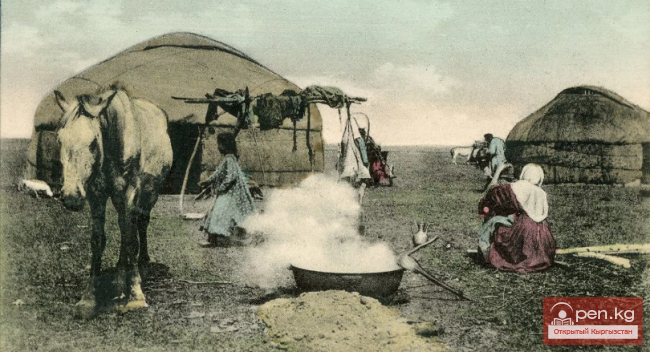Kyrgyzstan is a small country bordering Uzbekistan, Kazakhstan, and Russia. The main attractions...

Broad-eared bat Status: Category VII, Lower Risk/least concerned, LR/lc....
Ordo Sakhna – The Folk Ethnographic Theater. Biography. The folk ethnographic theater Ordo Sakhna...
Airport Manas. Bishkek. Kyrgyzstan. Kyrgyzstan. Bishkek. Airport Manas...

Sheltopusik Status: Near Threatened (category NT). A rare widely distributed representative of a...

Imanov Engel Tsanakeevich (1935), Doctor of Veterinary Sciences (1990), Professor (1995), Laureate...

Kyrgyzstan has been included in the top twenty tourist destinations of 2016 by National Geographic...

Common Water Shrew Status: Category VI, Near Threatened, NT: R. A rare species for Kyrgyzstan,...

Gray Monitor Status: Category CR A4bc; E. In Kyrgyzstan - fragmented populations of the declining...

Aktagan-chai In Kyrgyzstan, it is customary to drink tea not from regular cups, but from bowls...

Chon Kojo - an ancient dish of the Kyrgyz. It is prepared for Nauryz. On this day, everyone...

The Cruelty of Nasr-Eddin Towards Uzbek, Kyrgyz, and Tajik Workers On September 22, Nasr-Eddin...

Umach ash (soup-zatirukha) Ingredients: 2 liters of broth, 300 g of meat, 300 g of wheat flour,...

Bal (sweet drink) Popular among the Kyrgyz, bal is a sweet hot drink made from honey with the...

Natural and ecological complexes: Shamsi Natural Complex Ala-Archa National Park Chon-Kemin Zone...

Historical-Architectural and Modern Attractions, as well as Natural-Ecological Complexes Cities...
Motorcycle Journey Enduro Kyrgyzstan. Enduro Kyrgyzstan...

Kyrgyzstan or Kirghizia – a diamond in the Asian crown of ancient empires. The country is still...

Zhansak Any feast for Kyrgyz people begins and ends with tea, and it is customary to serve sweets...

Ash-airan This dish is known in folk medicine as a dietary option. It is suitable for those who...

Karataev Madaminzhan Musaevich (1962), Doctor of Medical Sciences (2000), Professor (2002) Kyrgyz....

Resettlement of the Kyrgyz to the Yenisei. The early medieval population of the Yenisei was...

From May 28 to June 5, 2015, a youth festival "Kyrgyz-American Hip-Hop Fest 2015" will...

This dish was mainly prepared by southern Kyrgyz tribes closer to autumn. At this time, the seeds...

Zhenmomo (dough balls) The basis of various flour dishes is dough. The Kyrgyz people have long...

SALAD "SUSAMYR", cold appetizer — a dish of Kyrgyz cuisine. Susamyr is a very tasty and...
100 years/ Style/ Kyrgyzstan. Limon.KG: How the image of the Kyrgyz man has changed...

The International Business Council has developed a vision for the development of the Kyrgyz...

Halvaitar — a liquid halvah-like mixture. Ingredients: 100 g of lamb fat or melted butter 100 g of...

Talcan Reference: talcan - coarse flour made from wheat or oats. One of the most beloved treats...

Karyn (horse stomach) This dish is for special guests. Its name comes from the stomach (karyn). It...
An alternative for the tourism video of Kyrgyzstan. This video was shown in Sochi, where our...

Ingredients: Starch noodles - 120g, carrot - 130g, radish - 200g, vegetable oil - 100g, garlic -...

Bearded Vulture Status: Category VI, Near Threatened, NT: R. The only representative of the genus...
Kyrgyzstan is a beautiful country! The video was created by Antares Creative Group on behalf of...

Lamb Stuffed with Tail Fat Ingredients lamb 180 g garlic 5 g jussai (Chinese chives) 10 g tail fat...
Bishkek, Orto-Tokoy Reservoir. September, 2013....

Mastava Mastava is a type of soup. Besides Kyrgyzstan, it is prepared in many countries of Central...

Tan-mosho Ingredients: 0.5-1 liter of liquid (milk, water, or a mixture of both), 1/2 cup of...

Ala-Too Cutlets Ala-Too is a dish from Kyrgyz cuisine. It is a meat dish made from lamb served...

Karta. Karta – a popular dish in Kyrgyzstan. To prepare the meat delicacy karta, we will need the...

Shirin alma. In translation from Kyrgyz, it means – sweet apple. To prepare this dish, you do not...

html Turkestan Catfish Status: 2 [VU: E]. The only representative of the genus in...

Köche To prepare this dish in ancient times, corn, wheat, or barley was ground in a mortar. The...

The coolest gaming event in the Kyrgyz Republic! The Central Asia Games Show (CAGS) will take...

Salad "Ozgiche" Ingredients: Chicken liver or stomach 48 Fresh or pickled cucumbers 10...